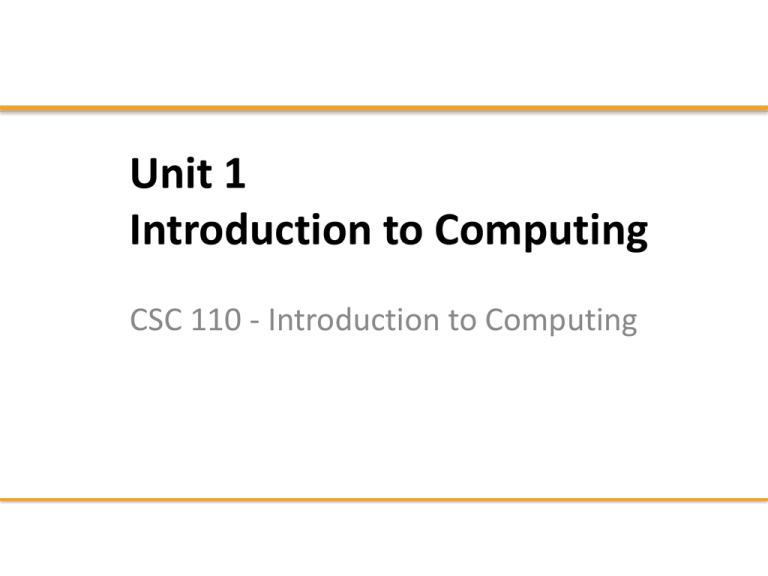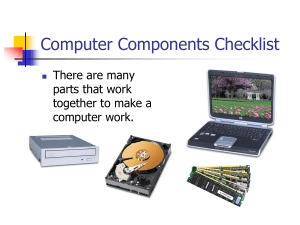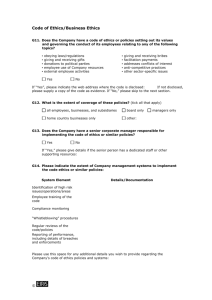computer
advertisement

Unit 1 Introduction to Computing CSC 110 - Introduction to Computing Learning Objectives At the end of this learning unit, you will be able to • Describe computer systems. • Identify computer hardware and software. • List the main functions of operating systems. • List the main functions of Windows 8 operating system. • Discuss computer ethical issues. 1-2 Computer Concepts 1-3 What Is a Computer? • A computer is an electronic device, operating under the control of instructions stored in its own memory Collects data (input) Processing Produces information (output) Information Processing Cycle 4 Understanding Computer Systems • Computer system – Combination of all the components required to process and store data using a computer • Hardware – Equipment associated with a computer • Software – Computer instructions: tell the hardware what to do – Programs: instructions written by programmers 1-5 Computer Systems: Hardware • Computer hardware components are the physical pieces of the computer. • The major hardware components of a computer are: – – – – The central processing unit (CPU) Main memory Secondary storage devices Input and Output devices 1-6 Computer Systems: Hardware 1-7 Computer Systems: Hardware Central Processing Unit CPU Instruction (input) Arithmetic Logic Unit Result (output) Control Unit 1-8 Computer Systems: Hardware Main Memory • Commonly known as random-access memory (RAM) • RAM contains: – currently running programs – data used by those programs. • RAM is divided into units called bytes. • A byte consists of eight bits that may be either on or off, or 1 or 0. 1-9 Computer Systems: Hardware Main Memory • A bit is either on or off: 1 1 1 1 – 1 = on – 0 = off 0 0 0 0 • The bits form a pattern that represents a character or a number. • Each byte in memory is assigned a unique number known as an address. • RAM is volatile, which means that when the computer is turned off, the contents of RAM are erased. 1-10 Computer Systems: Hardware Secondary Storage Devices • Secondary storage devices are capable of storing information for longer periods of time (non-volatile). • Common Secondary Storage devices: • Disk drive • External drive • CD drive • Solid state drive • USB drive • DVD drive 1-11 Computer Systems: Hardware Input Devices • Input is any data the computer collects from the outside world. • That data comes from devices known as input devices. • Common input devices: – – – – Keyboard Mouse Scanner Digital camera 1-12 Computer Systems: Hardware Output Devices • Output is any data the computer sends to the outside world. • That data is displayed on devices known as output devices. • Common output devices: – Monitors – Printers • Some devices such as disk drives perform input and output and are called I/O devices (input/output). 1-13 Computer Systems: Software • Software, also called a program, tells the computer what tasks to perform and how to perform them • Installing is the process of setting up software to work with the computer, printer, and other hardware • There are two classifications of software: – Operating Systems – Application Software 1-14 Software: Operating Systems • An operating system (OS) is a set of programs containing instructions that work together to coordinate all the activities among computer hardware resources Start and shut down a computer Provide a user interface Manage programs Manage memory Coordinate tasks Configure devices Establish an Internet connection Monitor performance Provide utilities Automatically update Control a network Administer security 15 Software: Operating Systems • A stand-alone operating system is a complete operating system that works on a desktop computer, notebook computer, or mobile computing device. – – – – Unix Linux Mac OS Windows (for example: Windows 7, Windows 8) 16 Software: Operating Systems Operating Systems Functions: • Operating system controls various shut down options such as sleep mode, hibernate. • A user interface controls how you enter data and instructions and how information is displayed on the screen • It determines the order in which tasks are processed • Plug and Play automatically configures new devices as you install them • A driver is a small program that tells the operating system how to communicate with a specific device, such as printer driver. 17 Software: Application Software • Application software refers to programs that make the computer useful to the user. • Application software provides a more specialized type of environment for the user to work in. • Common application software: – – – – – Spreadsheets Word processors Accounting software Tax software Games 1-18 Windows 8 1-19 Windows 8 Operating System • • • • Released by Microsoft in 2012 Designed to operate on touch-screen devices Available for laptops, desktops, and tablet computers Performing Tasks in Windows 8 • Use the mouse • Touch the screen on touch-enabled devices • Use keystroke commands 1-20 Common Touch Gestures • • • • Press and hold Tap Slide Swipe • Zoom • Turn • Swipe from edge 1-21 Start Screen Components • • • • Windows 8 interface is the name of the Start screen The screen contains tiles to hold apps The screen is where you begin all activities Most used applications are in one location on the screen 1-22 Charms Bar • Provides quick access to actions that are frequently used • Windows key + C to access by keystroke • Move mouse to top- or bottom-right corner of screen to access by mouse • Contains five icons • Replaces the Start button 1-23 Windows 8 Search • Using the Charms Bar 1-24 Computer ethic issues 1-25 Ethics • Ethics are standards of moral conduct – Standards of right and wrong behavior – A gauge of personal integrity – The basis of trust and cooperation in relationships with others 1-26 Computer Ethics • Computer ethics are morally acceptable use of computers. – i.e. using computers appropriately. • Standards or guidelines are important in this industry, because technology changes are outstripping the legal system’s ability to keep up. 1-27 Computer Ethics • Four primary issues – Privacy – responsibility to protect data about individuals – Accuracy - responsibility of data collectors to authenticate information and ensure its accuracy – Property - who owns information and software and how can they be sold and exchanged – Access - responsibility of data collectors to control access and determine what information a person has the right to obtain about others and how the information can be used 1-28 E-Mail Netiquette • Promptly respond to messages. • Delete messages after you read them if you don’t need to save the information. • Don’t send messages you wouldn’t want others to read. • Keep the message short and to the point. • Don’t type in all capital letters. • Be careful with sarcasm and humor in your message. 1-29 Computer Crime • Computer criminals -using a computer to commit an illegal act • Who are computer criminals? – Employees – disgruntled or dishonest --the largest category – Outside users - customers or suppliers – “Hackers” and “crackers” - hackers do it “for fun” but crackers have malicious intent – Organized crime - tracking illegal enterprises, forgery, counterfeiting 1-30 Types of Computer Crime • Damage to computers, programs or files – Viruses - migrate through systems attached to files and programs – Worms - continuously self-replicate • Theft – Of hardware, software, data, computer time – Software piracy - unauthorized copies of copyrighted material • View/Manipulation – “Unauthorized entry” and “harmless message” still illegal 1-31 Computer Security • Computer security involves protecting: – information, hardware and software – from unauthorized use and damage and – from sabotage and natural disasters 1-32 Measures to Protect Computer Security • Restricting access both to the hardware locations (physical access) and into the system itself (over the network) using firewalls • Implementing a plan to prevent break-ins • Changing passwords frequently • Making backup copies • • • • Using anti-virus software Encrypting data to frustrate interception Anticipating disasters (disaster recovery plan) Hiring trustworthy employees 33 Computer Ethics for Computer Professionals • Competence– Professionals keep up with the latest knowledge in their field and perform services only in their area of competence. • Responsibility– Professionals are loyal to their clients or employees, and they won’t disclose confidential information. • Integrity– Professionals express their opinions based on facts, and they are impartial in their judgments. 1-34





